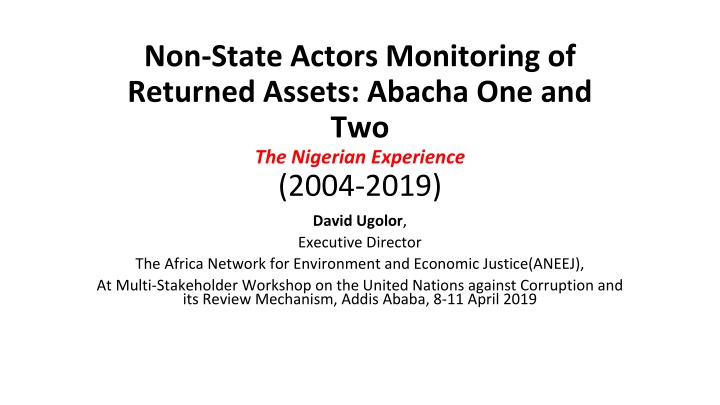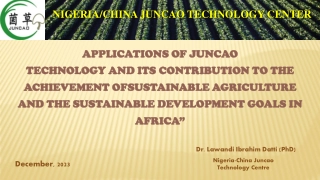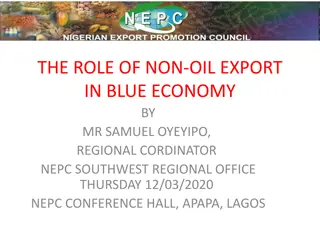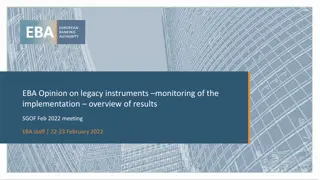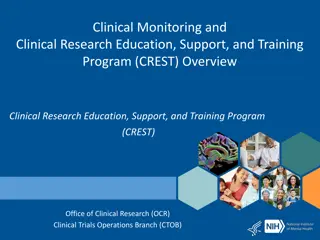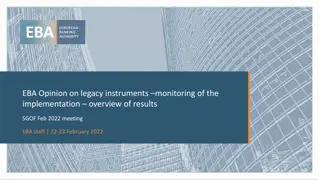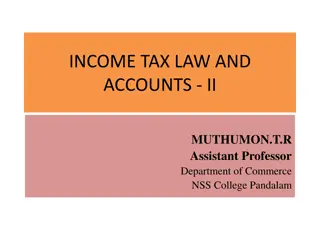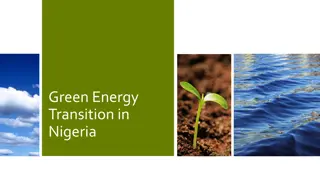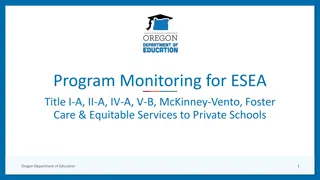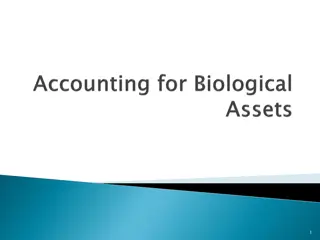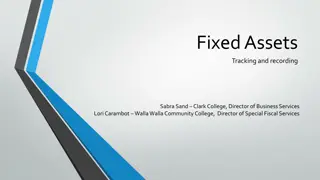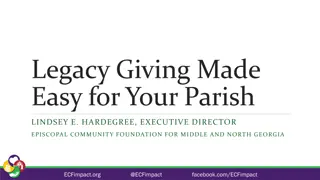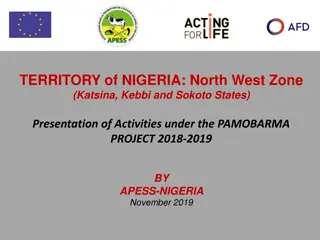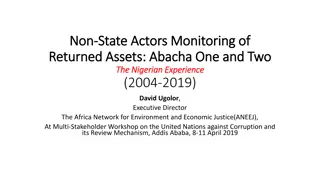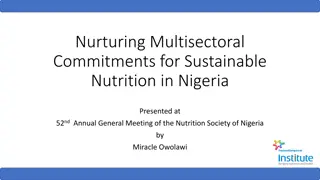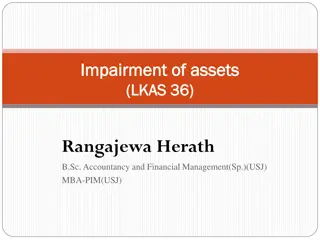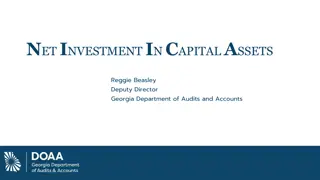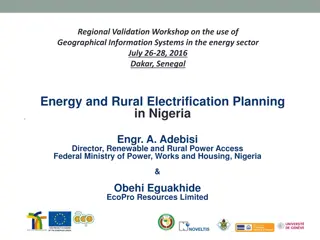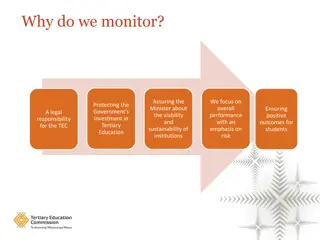Monitoring of Returned Assets: Abacha's Legacy in Nigeria
International efforts led by civil society in Nigeria and Switzerland have successfully monitored the return of assets linked to the Abacha regime. Initiatives like the Nigerian Network on Stolen Assets and the Conditional Cash Transfer program demonstrate transparency and accountability in handling the recovered funds. Future campaigns aim to reclaim additional assets from the United States, showcasing ongoing advocacy for financial justice.
Download Presentation

Please find below an Image/Link to download the presentation.
The content on the website is provided AS IS for your information and personal use only. It may not be sold, licensed, or shared on other websites without obtaining consent from the author.If you encounter any issues during the download, it is possible that the publisher has removed the file from their server.
You are allowed to download the files provided on this website for personal or commercial use, subject to the condition that they are used lawfully. All files are the property of their respective owners.
The content on the website is provided AS IS for your information and personal use only. It may not be sold, licensed, or shared on other websites without obtaining consent from the author.
E N D
Presentation Transcript
Non-State Actors Monitoring of Returned Assets: Abacha One and Two The Nigerian Experience (2004-2019) David Ugolor, Executive Director The Africa Network for Environment and Economic Justice(ANEEJ), At Multi-Stakeholder Workshop on the United Nations against Corruption and its Review Mechanism, Addis Ababa, 8-11 April 2019
Introduction: What to do with $505.5 million Abacha Loot? Civil Society from Nigeria and Switzerland organised an International Conference that brought stakeholders together to establish the first National platform to engage in advocacy on asset recovery in Nigeria The launching of the Nigerian Network on Stolen Assets(NNSA) provided the unique platform with which civil society used to demand for the monitoring in 2006 The Federal Government of Nigeria initially refused to accept civil society monitoring The Swiss Coalition on Abacha Loot and Nigerian Civil Society launched an international advocacy/lobby towards the Swiss and Nigerian Government Heinrich Boell Foundation and Swiss Government provided funding for the Joint Independent Monitoring The World Bank Produced an Official Report and Nigerian Civil Society also produced an Independent Report, Shadow Report on Abacha Loot . The Obasanjo s Government response to the Shadow Report was very poor
Disbursement of $322.5millions to 300,000 Poorest of the Poor in Nigeria(Abacha Two) The Swiss Court ruled that $321 millions of Abacha Loot should be returned to Nigeria and the World Bank should monitor the process The Nigeria and Swiss Government negotiated MOU for the return and Civil Society represented by David Ugolor of ANEEJ participated in the MOU negotiation process Both parties agreed to use the $322.5millions for Conditional Cash Transfer(CCT) for the Poorest of the Poor in Nigeria. Over 300,000 Poorest of the Poor were targeted to benefit from the cash disbursement ANEEJ initiated National Civil Society Monitoring of the $332.5m Programme: Monitoring Recovered Assets through Transparency and Accountability(MANTRA) with support from UKAID Over 30,778 are benefitting from the MANTRA Programme in Nigeria and the disbursement of the N5000 Monthly per person is currently ongoing
Campaign to Return the $480millions from the United States( Abacha Three) Research Advocacy towards the United States, United Kingdom and Jersey Nigerian Network on Stolen Asset(NNSA)/ANEEJ/MANTRA engagement to ensure civil society participation in the ongoing negotiation between Nigeria and US Government Civil Society exploring opportunities for global campaign to secure the application of GFAR Principles in the negotiation around the Abacha Three Organising Public Dialogue in Nigeria, UK and United States to provide civil society perspectives in the use of the Abacha Three
Structure of the Monitoring in Nigeria Advocacy Campaign Training Monitoring
Challenges and Lessons from the Monitoring Access to information and the cooperation of government agencies was not easy Fund transfer into 2005 National Budget and space for civic engagement was limited No access to the information on the entire projects and World Bank selected the 50 projects for monitoring Monitoring Tools was developed by the Consultant hired by World Bank without the input of Civil Society Funding to sustain a long-term institutional framework was not available even though the Busan and Accra Commitments provided political support Building alliance between Civil Society from requesting and requested countries provides a platform to sustain civic engagement on asset recovery Public Outreach through the Shadow Report on Abacha Loot provides public information
Lessons from Abacha One, Two and Three Civil Society critical role in raising public awareness provided credible source of information for the citizens and media Cooperation between Civil Society and Government provided alternative perspectives to the MOU developed between the Nigerian and Swiss Government Civil Society monitoring of the recovered assets provided check against re- looting Returning of Abacha loot help to raise awareness on how political leaders abuse the position for private benefit Civil Society started to work closely with NGOs in Switzerland and also engaging the Swiss Embassy/government
GFAR and Accountable Asset Return Principles https://cifar.eu/wp-content/uploads/2018/10/20171206_gfar_communique.pdf GFAR Ten Principles Partnership Strengthening anti-corruption and development Mutual Interest Early Dialogue Transparency and Accountability Beneficiaries Case- Specific Treatment Consider using an Agreement under UNCAC Article 57(5) Preclusion of Benefit to offenders Inclusion of non-governmental Stakeholders
Accountable Asset Return Principles https://star.worldbank.org/sites/star/files/cso_user_guide_ukraine_- _english_final.pdf
Recommendations Civil Society should strengthen their capacity to engage the government Broad alliance will provide more impact in the public awareness across the country The media, professional groups and community based organization should be involved in the monitoring Context should be considered when considering which method to adopt in producing a report. The medium to share the report should be considered and how to use the report to influence policy that will strengthen transparency and accountability Legal framework for monitoring should be design to provide support to all stakeholders
